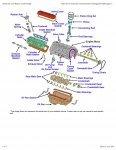Re: Winterizing
Ok... Some very basics...
Your power package consists of 3 major assemblies. The engine (looks just like a V6 car engine, because (in most part) it is... On this engine you will find a serial number. That identifies the engine and is unique to yours. It would be a good idea to find that serial number and record it. Then whenever you need parts, or help here, you can quote that number... You'll find the serial number in 2 places, but one may not be there, depending on how lazy the installer was that day :facepalm: The first place to look is the very top of the engine. There is a cover and on that cover is a number The format of the number is 0, and letter of the alphabet, then 6 numbers. If you can't find it on the cover, then on the starboard side of the engine, near the back will be a small (about 1"x2") metal plate, with 'Mercury Marine' on it, and the number....
The next major assembly to consider is the drive. That's on the outside of the boat, with the propeller on it, and it looks like the lower half of an outboard engine, because it is... That will also have a serial number, with the same format as the engine serial number. It should be on the decal on the top half on the port side. Again, any time you are working with the drive, that number is key.
The 3rd assembly is what holds these previous 2 together, the gimbal housing and the inner transom plate. It also has it's own serial number, right at the top, on the outside.
There is some wonderful information about terminology in the stickies, at the top of the forums...
Here's a link to them...
http://forums.iboats.com/mercruiser...have-technical-information-diyers-342393.html
If you scroll down on that, you find all sorts of information... Have fun with that...
Now, let's start with the engine. The part of the system that lives inside the boat...Just a car engine with a few marine bits thrown on.
The engine consists of the main casting, the block, that the crankshaft, pistons and camshaft (and a few other things, but we can leave them for the moment) reside in. The block, or crankcase, is cast iron. On top of each side of the block are the cylinder heads. The 'heads' holds the valves. These valves allow the fuel charge to be sucked into the combustions chamber, ready to make power, and be blown out as exhaust once the fuel has done its job. In the centre of the engine is a casting, the intake manifold. This manifold connects the carburettor (mixes air and fuel together in the right ratio, about 14:1, and controls the engine revs) to the valves in the head so the fuel is delivered to the cylinder.. The exhaust manifold collects the exhaust gas and channels them out throw the exhaust elbow (the large bulge at the centre of the manifolds) to be expelled outside the boat...
The crankshaft is the large thing that sits in the bottom of the block and spins around. It has rod coming off it, that connect to the pistons that go up and down in the cylinders. The fuel being burnt above the pistons is what drives then down with force, and that is how the engine creates power.. Have a look at '
Bondo's' avatar. It's a 4 cycle engine in motion. It shows a single cylinder running in an engine. You can see the valves at the top of the engine working, and the crankshaft in the bottom turning... It's a very good GIF...
I have left my signature on this post (I normally turn it off so pages load faster and use less space) so you can see how some of us put our engine and drive serial numbers in our signature files. That way, the numbers are always there when we start a new thread... You've come close with the little 'signature you have... The addition of the serial numbers would make if perfect :thumb:
Chris......
(Happy to answer any other questions)...





















